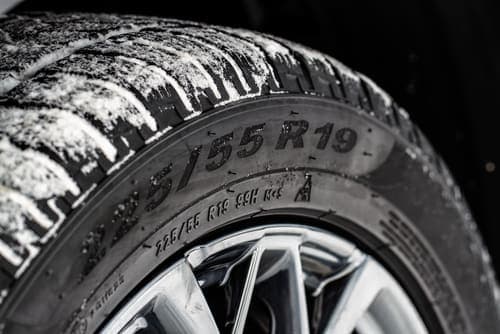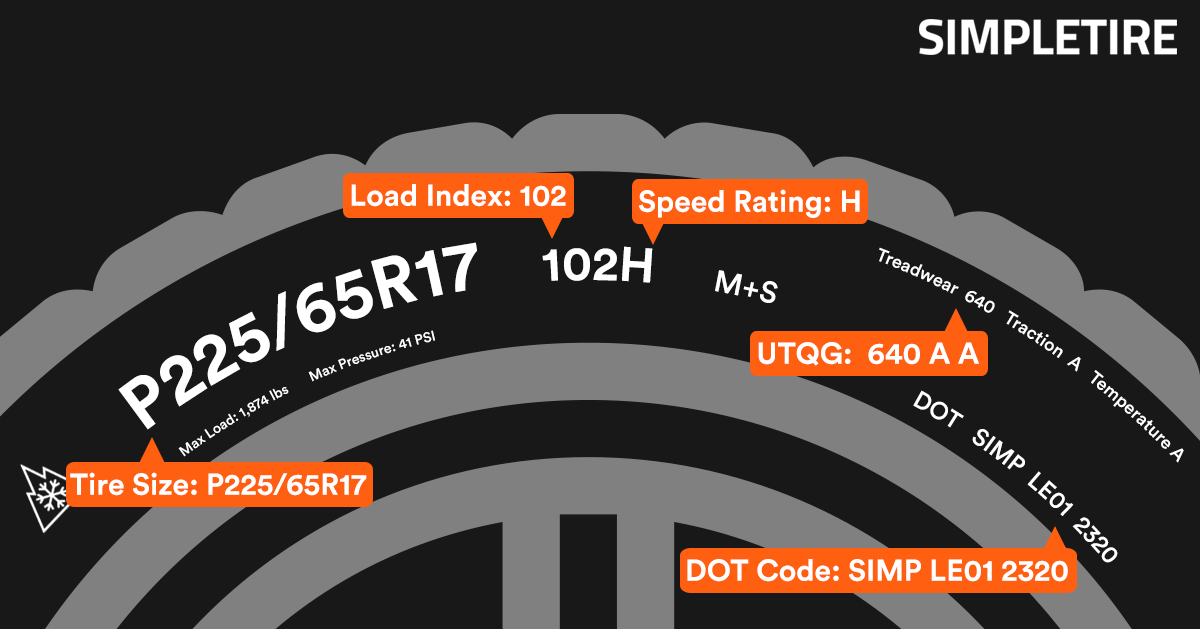Tire Buying Guides
Free shipping
Best price guarantee
Special pricing
Financing with Resolve
Easy returns

Every tire carries a code that reveals its true capabilities and limitations. This alphanumeric sequence, stamped right on the sidewall, contains vital information about how much weight your tire can support and how fast it can safely travel.
Understanding these specifications helps ensure your vehicle performs safely and efficiently. The numbers and letters that make up a tire's service description aren't random—they follow standardized ratings that apply across all tire manufacturers and types.
Your tires' load index and speed rating work together to define their performance envelope. These ratings affect everything from handling and braking to overall safety, making them essential factors to consider when selecting new tires for your vehicle.
What is a Tire Service Description?
Definition and Location

A tire service description consists of a standardized code that appears on every tire's sidewall, providing crucial information about the tire's weight capacity and speed capabilities. This code typically appears immediately after the tire size designation—for instance, in the marking "225/50R17 94H," the "94H" represents the service description.
The service description breaks down into two distinct components: a numerical load index (94 in our example) followed by an alphabetical speed rating (H). Together, these elements tell you exactly what performance limits the tire manufacturer has engineered into the product. The load index indicates the maximum weight each tire can support when properly inflated, while the speed rating shows the highest sustained speed the tire can handle without compromising safety or structural integrity.
Why Tire Service Descriptions Matter
These codes serve as your primary guide to selecting tires that match your vehicle's requirements and your driving needs. Installing tires with inadequate load ratings can lead to catastrophic failure, especially when carrying heavy cargo or towing trailers. Similarly, exceeding a tire's speed rating for extended periods causes excessive heat buildup that can damage the tire's internal structure.
Understanding service descriptions becomes even more critical when replacing tires or upgrading to different sizes. Your vehicle manufacturer specifies minimum load and speed requirements based on extensive testing—these specifications account for your vehicle's weight distribution, suspension design, and performance capabilities. Choosing tires that meet or exceed these requirements ensures optimal handling, braking performance, and compatibility with safety systems like traction control and stability management.
The service description also influences tire construction and durability. Higher load indexes typically require reinforced sidewalls and additional belt layers, while elevated speed ratings demand specialized rubber compounds that resist heat buildup at high velocities. These construction differences affect ride quality, fuel economy, and tread life—making the service description a key factor in matching tires to your specific driving conditions and preferences.
Understanding Tire Load Index
What Load Index Numbers Mean
The load index serves as an essential part of tire specifications, denoting the weight capacity each tire can handle. This numerical code, often between 75 and 120 for passenger vehicles, directly corresponds to a specific weight limit in pounds. For instance, a load index of 94 translates to a carrying capacity of 1,477 pounds for each tire. This ensures your tires can safely manage the weight of your vehicle, along with any additional load from passengers or cargo.
How to Calculate Your Vehicle's Load Capacity
To assess your vehicle's total load capacity, multiply the weight capacity of one tire by the total number of tires. For example, with four tires each rated at a load index of 94, the combined support will be 5,908 pounds. This calculation is key to ensuring your tires meet your vehicle's weight demands. It's crucial to select tires that fulfill or surpass the load index specified by your vehicle's manufacturer to maintain safety and performance.
Refer to your vehicle's owner's manual or the placard on the driver's door for the recommended load index. Adhering to these guidelines is vital for safe driving and ensures that your tires perform as expected. Using the correct load index prevents overloading, which can lead to tire issues, ensuring a stable and secure driving experience.
Decoding Tire Speed Ratings
What Speed Rating Letters Mean
Speed ratings indicate the highest speed a tire can maintain safely, represented by letters. For example, S (112 mph), T (118 mph), H (130 mph), V (149 mph), and W (168 mph) are common ratings. This letter appears as the last character in the tire's service description, serving as a quick guide to its speed potential.
The sequence of letters generally reflects increasing speed capabilities, although some, like H and V, are exceptions due to historical reasons. These ratings are essential for ensuring that tires meet the demands of various driving conditions, which supports vehicle performance.
Speed Rating Safety Considerations
Adhering to your tire's speed rating is crucial for maintaining optimal tire function. Exceeding these limits may stress the tire's components, potentially compromising its integrity. The ratings are not solely about speed—they also reflect the tire's ability to cope with the demands of high-speed driving.
Winter tires often feature lower speed ratings, aligning with the need for cautious driving in snow and ice. This adjustment reflects the typical conditions where high-speed capabilities are not a priority. Always consider the lowest speed rating among your tires, as it determines the maximum safe speed for your vehicle. Staying within these limits ensures proper handling and helps maintain the tire's condition over time.
Common Load Index and Speed Rating Combinations
Passenger Car Ratings
Passenger vehicles generally utilize load indexes ranging from 84 to 95. These indexes ensure stability and adequate support for a variety of passenger loads. Sedans and small SUVs typically have speed ratings such as T or H, which accommodate speeds of up to 118 mph and 130 mph, respectively.
A common configuration for these vehicles might be the 91T rating. This setup supports a load capacity of 1,356 pounds per tire, aligning with everyday driving needs while ensuring safety and efficiency on the road.
Light Truck and SUV Ratings
Light trucks and SUVs require higher load indexes, typically between 100 and 116, to handle increased weight from cargo and towing tasks. These vehicles often feature speed ratings like S or T, focusing on managing heavier loads at speeds up to 112 and 118 mph.
Some performance SUVs, despite their heavier build, are equipped with higher speed ratings such as V or W. This allows for enhanced performance without compromising their capacity to manage substantial weights. Such versatility is crucial for matching tire specifications to the vehicle's design and intended use.
How Load Index and Speed Ratings Affect Tire Performance
Impact on Handling and Safety
Tires with higher load indexes often feature robust sidewall construction. This increased strength helps in maintaining vehicle stability, especially when carrying heavier loads. Enhanced sidewall design contributes to better cornering and steering response, providing drivers with improved control during various maneuvers.
Speed ratings influence tire design by dictating the materials used for optimal temperature management. Tires designed for higher speeds incorporate innovative technology to prevent overheating and ensure consistent performance. Properly rated tires deliver balanced handling and braking, enhancing overall safety and confidence on the road.
Relationship to Tire Construction
To support heavy loads, tires are engineered with specific structural enhancements. These include reinforced internal components that sustain the tire's shape under pressure, extending its lifespan and reliability. This design ensures that tires can meet the demands of both everyday driving and more challenging conditions.
For speed capability, advanced materials and design techniques are employed. These elements enable tires to withstand the dynamic forces encountered at high speeds, maintaining their integrity and grip. Both load index and speed rating are crucial in determining a tire's endurance and its ability to perform effectively across different driving scenarios.
Choosing the Right Load Index and Speed Rating
Matching Your Vehicle's Requirements
When selecting tires, it's crucial to align with your vehicle's needs. The manufacturer's specifications are designed to accommodate the vehicle's weight and intended use. These guidelines ensure your tires handle everyday driving conditions safely.
Consider any changes to your vehicle, such as added weight or modifications. Enhancements like suspension lifts or additional cargo may require tires with greater load capacities. Check with tire experts to confirm the best options for your specific requirements.
When to Consider Higher Ratings
Certain circumstances necessitate more robust tires. Regularly towing trailers or carrying heavy loads means opting for a higher load index to ensure stability and safety. Performance modifications might also benefit from higher speed ratings, allowing for optimal handling.
Challenging driving conditions, such as rough terrains or extreme climates, demand tires with enhanced durability. Choosing tires with higher ratings provides peace of mind and longevity, as they are built to withstand more demanding environments.
Reading Your Current Tire Specifications
Finding Your Tire Information
Begin by inspecting the sidewall of each tire for critical data. This section holds essential numbers and letters that reveal the tire's dimensions and capabilities. Identifying these details is key to comprehending the limits of your tires.
Check the placard on the driver’s door for the manufacturer’s advice. This label includes important specifications and guides you in finding suitable tire replacements. Your vehicle’s owner’s manual also serves as a reliable source for understanding original equipment specifications.
Utilize online tools to decode your tire information. Entering details from the sidewall helps confirm compatibility and explore other options that meet your vehicle’s needs.
Understanding Manufacturer Recommendations
Manufacturers set specific load and speed standards to align with your vehicle’s engineering. These recommendations ensure your tires can handle regular driving demands and any extra weight or stress.
Sticking to these guidelines helps protect warranty coverage, guaranteeing that your tires function as intended. Proper tire specifications also ensure compatibility with systems like Tire Pressure Monitoring Systems (TPMS) and stability control, which depend on correct tire performance.
Understanding your tire's load index and speed rating empowers you to make informed decisions that keep you safe on the road. These specifications work together to ensure your vehicle performs optimally, whether you're commuting to work or embarking on a cross-country adventure. When you're ready to put this knowledge into practice, we make it easy to shop for tires online and find the best deals that match your exact specifications and driving needs.
Ready to find the perfect tires?
Search By